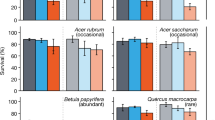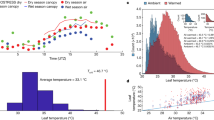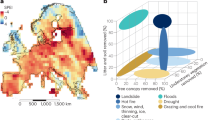Abstract
Competition for light has profound effects on plant performance in virtually all terrestrial ecosystems. Nowhere is this more evident than in forests, where trees create environmental heterogeneity that shapes the dynamics of forest-floor communities1–3. Observational evidence suggests that biotic responses to both anthropogenic global warming and nitrogen pollution may be attenuated by the shading effects of trees and shrubs4–9. Here we show experimentally that tree shade is slowing down changes in below-canopy communities due to warming. We manipulated levels of photosynthetically active radiation, temperature and nitrogen, alone and in combination, in a temperate forest understorey over a 3-year period, and monitored the composition of the understorey community. Light addition, but not nitrogen enrichment, accelerated directional plant community responses to warming, increasing the dominance of warmth-preferring taxa over cold-tolerant plants (a process described as thermophilization6,10–12). Tall, competitive plants took greatest advantage of the combination of elevated temperature and light. Warming of the forest floor did not result in strong community thermophilization unless light was also increased. Our findings suggest that the maintenance of locally closed canopy conditions could reduce, at least temporarily, warming-induced changes in forest floor plant communities.
This is a preview of subscription content, access via your institution
Access options
Subscribe to this journal
Receive 12 digital issues and online access to articles
$119.00 per year
only $9.92 per issue
Buy this article
- Purchase on Springer Link
- Instant access to full article PDF
Prices may be subject to local taxes which are calculated during checkout


Similar content being viewed by others
References
Freckleton, R. P. & Watkinson, A. R. Asymmetric competition between plant species. Funct. Ecol. 15, 615–623 (2001).
Gilliam, F. S. The Herbaceous Layer in Forests of Eastern North America 2nd edn (Oxford Univ. Press, 2014).
Coomes, D. A. & Grubb, P. J. Impacts of root competition in forests and woodlands: a theoretical framework and review of experiments. Ecol. Monogr. 70, 171–207 (2000).
Scheffers, B. R., Edwards, D. P., Diesmos, A., Williams, S. E. & Evans, T. A. Microhabitats reduce animal's exposure to climate extremes. Glob. Change Biol. 20, 495–503 (2013).
Melin, M. et al. Moose (Alces alces) reacts to high summer temperatures by utilizing thermal shelters in boreal forests – an analysis based on airborne laser scanning of the canopy structure at moose locations. Glob. Change Biol. 20, 1115–1125 (2014).
De Frenne, P. et al. Microclimate moderates plant responses to macroclimate warming. Proc. Natl Acad. Sci. USA 110, 18561–18565 (2013).
Kearney, M. R. Activity restriction and the mechanistic basis for extinctions under climate warming. Ecol. Lett. 16, 1470–1479 (2013).
von Arx, G., Pannatier, E. G., Thimonier, A. & Rebetez, M. Microclimate in forests with varying leaf area index and soil moisture: potential implications for seedling establishment in a changing climate. J. Ecol. 101, 1201–1213 (2013).
Verheyen, K. et al. Driving factors behind the eutrophication signal in understorey plant communities of deciduous temperate forests. J. Ecol. 100, 352–365 (2012).
Bertrand, R. et al. Changes in plant community composition lag behind climate warming in lowland forests. Nature 479, 517–520 (2011).
Gottfried, M. et al. Continent-wide response of mountain vegetation to climate change. Nature Clim. Change 2, 111–115 (2012).
Devictor, V. et al. Differences in the climatic debts of birds and butterflies at a continental scale. Nature Clim. Change 2, 121–124 (2012).
Gold, S., Korotkov, A. V. & Sasse, V. The development of European forest resources, 1950 to 2000. Forest Policy Econ. 8, 183–192 (2006).
Rautiainen, A., Wernick, I., Waggoner, P. E., Ausubel, J. H. & Kauppi, P. E. A national and international analysis of changing forest density. PLoS ONE 6, e19577 (2011).
Pretzsch, H., Biber, P., Schuetze, G., Uhl, E. & Roetzer, T. Forest stand growth dynamics in Central Europe have accelerated since 1870. Nature Commun. 5, 4967 (2014).
Hautier, Y., Niklaus, P. A. & Hector, A. Competition for light causes plant biodiversity loss after eutrophication. Science 324, 636–638 (2009).
Borer, E. T. et al. Herbivores and nutrients control grassland plant diversity via light limitation. Nature 508, 517–520 (2014).
Gilliam, F. S. Response of the herbaceous layer of forest ecosystems to excess nitrogen deposition. J. Ecol. 94, 1176–1191 (2006).
De Schrijver, A. et al. Cumulative nitrogen input drives species loss in terrestrial ecosystems. Global Ecol. Biogeogr. 20, 803–816 (2011).
Rodríguez-Sánchez, F., De Frenne, P. & Hampe, A. Uncertainty in thermal tolerances and climatic debt. Nature Clim. Change 2, 636–637 (2012).
Westoby, M. A leaf-height-seed (LHS) plant ecology strategy scheme. Plant Soil 199, 213–227 (1998).
Grime, J. P. Plant Strategies, Vegetation Processes, and Ecosystem Properties 2nd edn (Wiley, 2001).
McDowell, N. G. & Allen, C. D. Darcy's law predicts widespread forest mortality under climate warming. Nature Clim. Change 5, 669–672 (2015).
Schulze, E.-D., Körner, C., Law, B. E., Haberl, H. & Luyssaert, S. Large-scale bioenergy from additional harvest of forest biomass is neither sustainable nor greenhouse gas neutral. GCB Bioenergy 4, 611–616 (2012).
Verkerk, P. J., Anttila, P., Eggers, J., Lindner, M. & Asikainen, A. The realisable potential supply of woody biomass from forests in the European Union. Forest Ecol. Manag. 261, 2007–2015 (2011).
Seidl, R., Schelhaas, M.-J., Rammer, W. & Verkerk, P. J. Increasing forest disturbances in Europe and their impact on carbon storage. Nature Clim. Change 4, 806–810 (2014).
Dickson, T. L. & Foster, B. L. Fertilization decreases plant biodiversity even when light is not limiting. Ecol. Lett. 14, 380–388 (2011).
Verstraeten, A. et al. Impact of declining atmospheric deposition on forest soil solution chemistry in Flanders, Belgium. Atmos. Environ. 62, 50–63 (2012).
De Schrijver, A. et al. Nitrogen saturation and net ecosystem production. Nature 451, E1 (2008).
Anderson, M. J. et al. Navigating the multiple meanings of beta diversity: a roadmap for the practicing ecologist. Ecol. Lett. 14, 19–28 (2011).
Acknowledgements
We are grateful to L. Willems, R. Gruwez, K. Ceunen, G. De bruyn, P. Miljkovic, L. Nelen, K. Van Nieuland and N. Verdoodt for field and laboratory assistance. Support for this work was provided by FWO postdoctoral fellowships to P.D.F. and A.D.S., and an ERC Consolidator Grant 614839 - PASTFORWARD to K.V.
Author information
Authors and Affiliations
Contributions
P.D.F., A.D.S., D.A.C., M.H. and K.V. designed the research; P.D.F. and A.D.S. performed the research; P.D.F. and F.R.S. analysed the data; all authors wrote the paper.
Corresponding author
Ethics declarations
Competing interests
The authors declare no competing financial interests.
Supplementary information
Rights and permissions
About this article
Cite this article
De Frenne, P., Rodríguez-Sánchez, F., De Schrijver, A. et al. Light accelerates plant responses to warming. Nature Plants 1, 15110 (2015). https://doi.org/10.1038/nplants.2015.110
Received:
Accepted:
Published:
DOI: https://doi.org/10.1038/nplants.2015.110
This article is cited by
-
Extinction drives recent thermophilization but does not trigger homogenization in forest understorey
Nature Ecology & Evolution (2024)
-
Microclimate and forest density drive plant population dynamics under climate change
Nature Climate Change (2023)
-
Novel light regimes in European forests
Nature Ecology & Evolution (2023)
-
Conflicting edge influence on herbaceous species in open areas vs. underneath oak trees in forest fragments in Iran
Plant Ecology (2023)
-
Divergent roles of herbivory in eutrophying forests
Nature Communications (2022)



